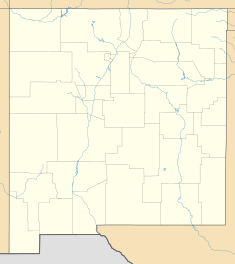Angostura Diversion Dam facts for kids
Quick facts for kids Angostura Diversion Dam |
|
|---|---|

Angostura Diversion Dam
|
|
|
Location of Angostura Diversion Dam in New Mexico
|
|
| Location | Sandoval County, New Mexico |
| Coordinates | 35°22′48″N 106°29′57″W / 35.379881°N 106.499032°W |
| Owner(s) | Middle Rio Grande Conservancy District |
| Dam and spillways | |
| Type of dam | Diversion dam |
| Height | 17 feet (5.2 m) |
| Length | 800 feet (240 m) |
| Elevation at crest | 5,083 feet (1,549 m) |
| Spillway capacity | 650 cubic feet (18 m3) per second |
The Angostura Diversion Dam is a special kind of dam on the Rio Grande river. It is located in Sandoval County, New Mexico. You can find it near the towns of Algodones and Bernalillo.
This dam helps to send water into a big irrigation canal. This canal provides water to farms and areas in the Albuquerque region.
What is the Angostura Diversion Dam?
The Angostura Diversion Dam is made of concrete. It is about 17 feet (5.2 m) (5.2 meters) tall. The dam stretches for about 800 feet (240 m) (244 meters) across the river.
A diversion dam is different from a regular dam. It doesn't store a lot of water in a big lake. Instead, it gently raises the water level. This allows water to be "diverted," or sent, into canals.
How Does It Work?
The dam's main job is to direct water into the Albuquerque Main Canal. This canal is very important for irrigation. Irrigation is how farmers get water to their crops.
The dam can divert a lot of water, about 650 cubic feet (18 m3) (18 cubic meters) of water every second. This is like filling a small swimming pool very quickly!
The dam has four special gates. These are called top-seal radial gates. Each gate is about 20 by 4 feet (6.1 by 1.2 m) (6.1 by 1.2 meters). These gates control how much water flows into the canal.
Who Built and Cares for It?
The Angostura Diversion Dam was built a long time ago, in 1934. It was built by a group called the Middle Rio Grande Conservancy District (MRGCD).
Later, in 1958, the dam was updated and made stronger. This work was done by the United States Bureau of Reclamation and the Corps of Engineers. They did this as part of a bigger plan called the Middle Rio Grande Project.
Today, the Middle Rio Grande Conservancy District (MRGCD) is still in charge. They make sure the dam works properly. They also handle all the daily care and upkeep.


